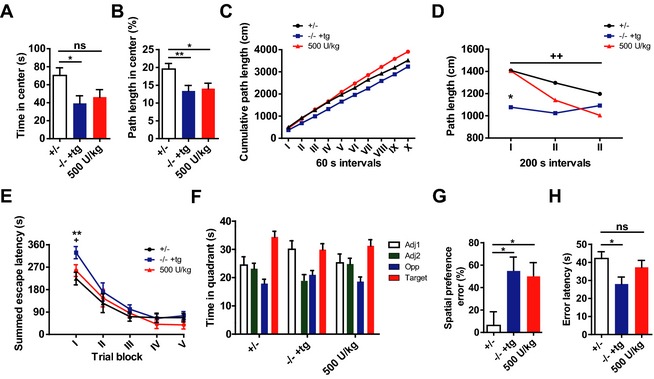Figure 5.

Long‐term high‐dose enzyme replacement therapy (ERT) partially rescues behavioral deficits. After 12–14 weeks of biweekly ERT with 500 U/kg, decreased exploratory activity of ‐/‐ tg+ mice is partially rescued (A–D). No improvement was found in spatial parameters, as reduced exploration of the center was unaltered (A; time in center and [B] % path length in center; main effects of Group P < 0.05). Cumulative path length indicated changes in temporal distribution of exploratory activity however (C). ERT‐treated ‐/‐ tg+ mice showed an initial exploratory peak in the beginning of the test with a progressive decline similar to control mice ([D]; interaction effect of Group × Time P < 0.05). Improvements after long‐term ERT were also found in the water maze task (E–G). Learning impairment in the acquisition phase was corrected after long‐term ERT (E; day I main effect of Group P < 0.05). However, no benefit was observed for long‐term memory in the probe trial. Control mice showed consistent preference for the target quadrant, while this was less pronounced for both ‐/‐ tg+ groups (F). Erroneous preference for other quadrants was indeed more frequent in both ‐/‐ tg+ groups, independent of treatment (G; main effect of Group P < 0.05). Treadmill performance was improved as well, as reflected in an increase of error latencies (H; main effect of Group P < 0.05). Asterisks indicate significant difference versus the control group: *P < 0.05; **P < 0.01. Plus‐signs indicate significance of difference versus mock‐treated ‐/‐ tg+ mice: + P < 0.05; ++ P < 0.01.
